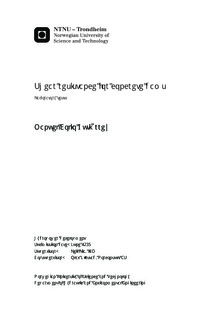| dc.description.abstract | The Mohr-Coulomb shear strength failure criterion is used nowadays by most of the countries in their guidelines to estimate the shear capacity between the dam and the foundation. However, the Mohr-Coulomb model does not take into consideration the roughness of the concrete-to-rock interface. The fact the roughness the influence of the roughness is ignored by the guidelines leads to an overestimation of the shear capacity between the dam and the rock. Therefore, there is a need to increase the understanding of the roughness influence on the shear capacity between the dam and the foundation, in order to be able to incorporate the roughness effect into the formulas to estimate the sliding stability of concrete dams founded on rock.This thesis aims to investigate the influence of the roughness in the shear capacity between the dam and the rock.The methodology followed to achieve this goal is the following:-Literature study in stability analysis of concrete dams and the methods to calculate the shear resistance between the dam and the rock at concrete dam foundations.-Literature study on shear strength of rough rock joints, the parameters affecting the shear capacity and the different models to estimate it.-Carry out direct shear tests at Lulea University of Technology (LTU).To investigate the effect of the roughness in the shear resistance of concrete-to-rock joints a series of direct shear tests was decided to be implemented in this thesis at Luleå University of Technology (LTU) in Sweden. In total 12 tests were conducted on concrete-rock specimens with a size of 240x240 〖mm〗^2. The surface of the rock specimens was artificially manipulated shaping them with triangular asperities of equal angles and lengths over the whole surface. Four different asperity angle profiles were tested; 40, 20, 10 and 0 degrees. The concrete specimens were obtained by casting concrete against the rock specimens. The concrete type used was B45/40. In order to study the effect of the bonding between the concrete and the rock in the shear resistance, four specimens were casted directly on the rock surface, while for the rest a plastic wrap was placed on the rock surface to avoid adhesion. The rock type used in the tests is gneiss and had a compressive strength of 159 MPa. The normal stress levels selected were 1.2 MPa, 2.2 MPa and 3.2 MPa. The results from the direct shear tests are shown in Table 1. The Table shows the normal load applied, N, the horizontal load applied, H, the normal stress, σ_n, peak shear stress, τ_max , shear displacement at peak, δ_(h,peak) , the maximum shear displacement, δ_(h,max), peak friction angle, ϕ_max.The results show that an increase on the asperity angle, the roughness, leads to a significant increase of the shear resistance of the concrete-to-rock joint. For the test carried out for a normal stress of 2.2 MPa, the peak shear stress obtained for an asperity angle of 40, 20 and 10 degrees was 4.73 MPa, 3.54 MPa and 1.97 MPa, respectively. It can be seen that the shear capacity for the 40 degrees asperity angle is over twice the shear capacity of the 10 degrees asperity angle. Both the normal load and the bonding between the concrete and the rock greatly influenced the shear resistance. For the specimens tested with bonding the shear capacity reached was a lot higher than for the ones tested without bonding. The failure mode of the concrete asperities was also depending on the roughness, for the lowest roughness (10 degrees), sliding was the governing failure mode occuring, while for 20 and 40 degrees the asperities were sheared off.The results from the direct shear tests have been tested into several shear strength failure criterion in order to check which one gave the best fit with the test results. The models that have been tested are the following:-Mohr-Coulomb model-Patton model-Barton & Choubey model-Maksimovic modelOut of the comparison between the predicted shear capacity from each model and the actual shear capacity observed from the tests, the model that gave the best fit was the model proposed by Barton and Choubey. A comparison of the results obtained from the tests with the Norwegian guidelines (NVE) has been also conducted. By comparing the shear capacity obtained from the tests with the Mohr-Coulomb model one realizes how conservative the actual NVE guidelines are due to the fact that the influence of the roughness in the shear capacity between the concrete and the rock is ignored. Moreover the basic friction angle estimated from the direct shear tests was found to be approximetaly 30 degrees and the reccommended basic friction angle by NVE to use when assessing the shear capacity between the dam and the rock is 45 degrees. This is another prove that the actual criterion used by NVE guidelines to estimate the sliding stability of concret dams does not capture in realistic way the nature of the shear phenomenon at the dam-rock interface.Finally, an attempt to develop an equation to estimate the peak shear stress of concrete-to-rock joint with surfaces shaped with triangular asperities is proposed based on the test results carried out by Liahagen (2012). The failure criterion proposed is based on the Mohr-Coulomb model but introducing a factor which incorporates the effect of the roughness into the shear capacity. The proposed model is tested into the test results carried out in this thesis, and the correlation seemed to be fairly good for 10 and 20 degrees asperity angle but not that good for the highest roughness tested, 40 degrees.The following topics shall be considered to take to further research:-Shear tests on concrete-to-rock under in-situ conditions-Further investigate the effect of bonding in the shear capacity-Direct shear tests on different rock types-Direct shear tests with specimens with irregular triangular asperity profiles | nb_NO |

